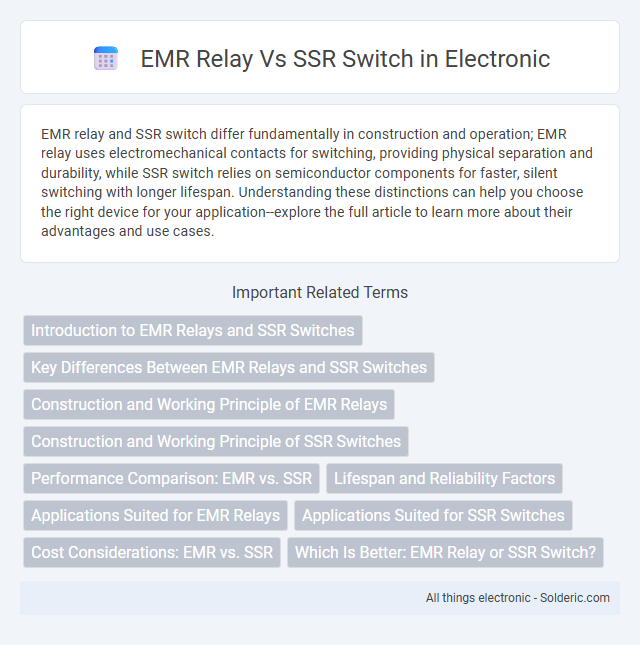EMR relay and SSR switch differ fundamentally in construction and operation; EMR relay uses electromechanical contacts for switching, providing physical separation and durability, while SSR switch relies on semiconductor components for faster, silent switching with longer lifespan. Understanding these distinctions can help you choose the right device for your application--explore the full article to learn more about their advantages and use cases.
Comparison Table
| Feature | EMR Relay | SSR Switch |
|---|---|---|
| Operating Principle | Electromechanical contacts | Solid-state semiconductor switching |
| Switching Speed | Slow (milliseconds) | Fast (microseconds to milliseconds) |
| Longevity | Limited mechanical life (~10^5 to 10^7 cycles) | High life cycles (>10^9 cycles) |
| Contact Wear | Contact degradation due to arcing | No physical contacts, no wear |
| Noise | Produces audible noise when switching | Silent operation |
| Size | Typically larger | Compact and lightweight |
| Power Consumption | Higher coil power required | Low power consumption |
| Load Types | Suitable for inductive, resistive, and capacitive loads | Best for resistive loads; special SSRs required for inductive |
| Cost | Generally lower initial cost | Higher initial cost but lower maintenance |
| Applications | Industrial machinery, relay logic circuits, high surge currents | Temperature control, automation systems, silent switching |
Introduction to EMR Relays and SSR Switches
EMR relays (Electro-Mechanical Relays) utilize physical moving parts to open and close electrical circuits, offering reliable switching for high-current and high-voltage applications. SSR switches (Solid State Relays) use semiconductor components to perform switching without mechanical movement, providing faster response times and longer lifespan with silent operation. Understanding the operational differences between EMR relays and SSR switches is crucial for selecting the appropriate device for specific control and automation tasks.
Key Differences Between EMR Relays and SSR Switches
EMR relays use electromagnetic coils to mechanically open or close contacts, providing physical isolation and tactile feedback, whereas SSR switches rely on semiconductor devices with no moving parts, offering faster switching and longer lifespan. EMRs are ideal for applications requiring high current and voltage handling with mechanical durability, while SSRs excel in silent operation and high-frequency switching. The choice depends on factors like load type, switching speed, durability, and electrical noise tolerance.
Construction and Working Principle of EMR Relays
EMR relays, or Electromechanical Relays, consist of a coil, armature, spring, and contacts housed in a robust enclosure, utilizing electromagnetic force for operation. When current flows through the coil, it generates a magnetic field that attracts the armature, causing the switch contacts to open or close, thus controlling the circuit. Unlike SSR switches that rely on semiconductor components, EMR relays provide a physical separation of contacts, enhancing reliability in certain applications while you consider switching solutions.
Construction and Working Principle of SSR Switches
SSR switches, or Solid State Relays, utilize semiconductor devices like thyristors, triacs, or transistors to perform switching without mechanical parts, enhancing durability and response speed. Their construction involves input control circuits and output power circuits electrically isolated by an optocoupler to prevent high voltage feedback. The working principle relies on input signal activation that triggers the semiconductor to conduct, enabling current flow without the physical contact seen in EMR relays.
Performance Comparison: EMR vs. SSR
EMR relays exhibit slower switching speeds, typically in the range of 5-15 milliseconds, compared to SSR switches which operate in microseconds to milliseconds, making SSRs ideal for high-speed applications. SSR switches offer superior durability and reliability due to their solid-state design, eliminating mechanical wear found in EMRs. Your choice between EMR and SSR should consider the required switching speed, lifetime, and electrical noise tolerance for optimal performance.
Lifespan and Reliability Factors
EMR relays typically offer a longer lifespan with up to 100 million mechanical operations under optimal conditions, whereas SSR switches provide virtually unlimited switching cycles due to their solid-state components. Reliability in EMR relays can be affected by mechanical wear, contact corrosion, and environmental factors like vibration and dust, while SSR switches excel in harsh environments with higher resistance to shock and vibration but may fail due to thermal stress or electrical surges. Choosing between EMR relays and SSR switches depends on application-specific lifespan requirements, switching frequency, and environmental conditions impacting reliability.
Applications Suited for EMR Relays
EMR relays are ideal for applications requiring robust isolation and handling of high inrush currents, such as industrial automation, motor control, and HVAC systems. Their mechanical contacts offer reliable switching for heavy loads and resist electrical noise, making them suitable for safety-critical environments and power distribution panels. You benefit from their durability and compatibility with legacy systems where precise control and long operational life are essential.
Applications Suited for SSR Switches
SSR switches excel in applications requiring silent operation, fast switching speed, and high reliability, such as industrial automation, HVAC systems, and lighting controls. These solid-state devices handle frequent on/off cycles without mechanical wear, making them ideal for processes demanding precise and consistent control. You benefit from SSR switches in environments where maintenance reduction and noise elimination are critical.
Cost Considerations: EMR vs. SSR
Electromechanical relays (EMRs) typically incur lower initial costs, making them a budget-friendly choice for applications with infrequent switching. Solid-state relays (SSRs), though more expensive upfront, offer longer lifespans and reduced maintenance costs due to the absence of mechanical parts, ultimately lowering total cost of ownership. Your choice should balance initial investment against reliability and maintenance expenses to optimize overall cost-effectiveness.
Which Is Better: EMR Relay or SSR Switch?
Choosing between an EMR relay and an SSR switch depends on your application's specific requirements, including load type, switching speed, and lifespan. EMR relays excel in handling high inrush currents and offer clear mechanical isolation, making them suitable for heavy-duty and high-voltage applications. SSR switches provide faster switching speeds, silent operation, and longer life without mechanical wear, ideal for precise control and frequent switching tasks.
EMR relay vs SSR switch Infographic

 solderic.com
solderic.com